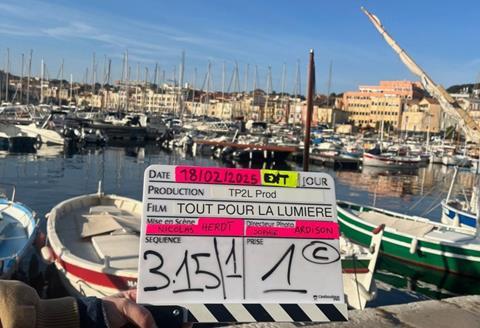From regional coproductions to global corporate alliances, there’s an unfortunate reality behind the surging popularity of partnerships
For those in the international game who’ve been on the road at the myriad events taking place in June, there’s probably one clear takeaway.
The market is tough.
This is not a new development, and neither is the fact that partnerships are now the name of the game - whether that’s from a regional coproduction point of view or as an M&A strategy for corporate giants.
The real question is how much more can the industry be squeezed.
Calling for a copro saviour
Look at production. For years, chunky scripted budgets required multiple financing partners to get shows off the ground, with US companies tending to do much of the heavy lifting.
Their lack of market activity has meant an ever-increasing reliance on coproductions, with most producers now trying to work out how to do business without a US partner.

And while it might be comforting to know that the odd US buyer remains active – thank goodness for Acorn TV and Outrageous commissioner BritBox International – their collective financing capabilities are limited in comparison to the giant vacuum left by the collective loss of the US majors.
The result is that for many producers, the financing road tends to be leading to the doors of squeezed European public broadcasters and their various collective commissioning groups such as The Alliance and the New8.
These groups must be commended for keeping the coffers open but - putting their reliance on public money to one side – competition for a commission is fierce.
The New8, for example, houses Germany’s ZDF, Belgium’s VRT, Sweden’s SVT, Denmark’s DR, Finland’s YLE, Norway’s NRK, NPO in the Netherlands and RUV in Iceland. Between them, they aim for around eight dramas a year, an ambitious number but one that still leaves hundreds – if not thousands - of pitching production companies without a home for projects.
Even in Spain, where scripted remains in demand thanks to increasing global appetite for Spanish-language shows, the talk is of a squeeze. Yes, there may be commissions but you can count on two hands which companies will get them, producers tell Broadcast International, and most of those are already part of global groups.
And while at times it might feel like the future of the industry is resting on multi-territory coproductions, spreading the burden of a budget across an increasing number of geographical locations also means distributors have fewer territories to sell.
Much has been written about the increasing reliance on international sales to justify deficit financing, but most senior distribution execs suggest gaps are not widening any further.
Instead, the fear among some senior production and distribution folks who have spoken to Broadcast International is that the cost of financing over recent years is not fully visible yet. Shows are being amortised over longer and longer periods to reduce their impact on the immediate future, pushing the long-tail revenue stream of a popular scripted series to its absolute limit.

For those at SunnySide of the Doc this week, a similar story of copro reliance was emerging among producers.
The once balmy waters of the US cablenet ecosystem have frozen. Networks are being sold off and producers are now grappling for partners to get shows made. Again, coproductions are nothing new here, but as one producer put it, the model has shifted from being employed to create ever more ambitious shows to now being used simply for survival.
All of this is not to say canny producers aren’t getting shows over the line, but it’s an increasingly difficult task. Sebastian Peiter, exec producer at Urban Canyons, probably put it best when discussing his Knights of the North project. It has Sweden’s SVT and Arte in France and Germany as lead commissioners, with producers in Latvia and Estonia joining as co-pro partners.
“In these difficult times, especially with the lack of American and Asian co-pro partners, high-end specialist factual can only survive in collaboration with European state broadcasters,” he says, “and by sharing workflow and rights with fellow European producers who can bring additional state and broadcaster funding from their territory.”
Take one element of this financing model away, and it’s not immediately clear what else there is to fill it.
From a position of strength or weakness?
Partnerships are top of mind for broadcasters too.
Few would have predicted even five years ago that France’s TF1 would want its channels and streaming service to be accessible via a major competitor.
Now, the agreement for TF1 channels and the TF1+ streamer to appear via Netflix is being positioned as a coup for the commercial broadcast giant.

The deal hands Netflix not just TF1 programming but also key sports events – French national football team rights, for example – and means the streamer can play in the same aggregation pool that Amazon Prime Video and its Channels business are in.
For TF1, the deal allows an incumbent – traditional, even - commercial broadcaster relying on advertising to expand its reach, especially among younger viewers, and gain some extra revenue in a challenging ad market.
But again, it’s tough to see such a partnership as anything other than a defensive play by TF1, and another ambitious step for Netflix as it looks to become the dominant – if not only – version of TV out there.
For producers, it is hard to see a huge amount of upside from this partnership.
TF1 and Netflix have already partnered on soap opera Tout Pour La Lumiere – the streamer’s first shift into daily drama in France – and a splurge in spending on brand-defining shows doesn’t seem like the most logical of conclusions to arrive at following a further narrowing of the dividing lines between the companies.
For Netflix, the partnership is something of a paradigm shift, and Broadcast International understands similar deals are being explored elsewhere. But it also underlines a new world order and, arguably, is more a partnership of necessity for one of Europe’s biggest broadcasters.
Mergers & acquisition motivation
Talk to execs in the upper echelons of groups, and the conversations are similar.
Not too long ago, M&A rumours involving the combination of groups or major indie acquisitions tended to be seen as a sign of expansion and bullishness.
Of course, no one wants their financial dealings to come out in public before the deal is signed and sealed, but there was an overriding feeling that a planned acquisition reflected a smaller firm’s success and a larger company’s ambition.

Now, by most accounts, the equation has reversed. As one senior US-based exec told me recently, everyone is talking to everyone when it comes to M&A, they just don’t want you to know about it.
To some extent it has been ever thus but the difference is the reason: today, most deals are coming from a point of weakness.
Smaller companies are feeling the pinch of a constrained market and looking for the relative safe harbour of a group, while bigger group-wide amalgamations are being explored because they offer tasty three-figure synergy savings.
RTL Group’s deal to buy Das Boot broadcaster Sky Deutschland for €150m (£128m) offers exactly that: €250m is expected in annual synergy savings within three years after the deal closes, the Fremantle owner said, hardly the kind of news employees will want to read on a sunny Friday morning.
The combination will also create a major German powerhouse, with streamers RTL+ and Wow from Sky cumulatively accounting for 11.5 million paying subscribers.
Thomas Rabe, RTL Group’s chief exec, said the deal would create “a unique video proposition across free TV, pay TV and streaming”, diversifying revenue streams and making the company “even more attractive for creative talent, rights holders and business partners.”
“Together, RTL and Sky will be in an even stronger position to invest in people, content and technology in Germany and in Europe to compete with the global tech and streaming players,” he said, snappily summing up the driving force beind change in the industry.
And whether it’s a regional coproduction that requires ever-more partners to result in a viable return for a producer, a broadcaster turning to a global streamer for more audience, or a billion-dollar M&A deal that enables synergy savings to keep profits rising (at least for the short term), it is clear that partnerships are no longer a choice.
They are a simple necessity to make the sums stack up.








No comments yet